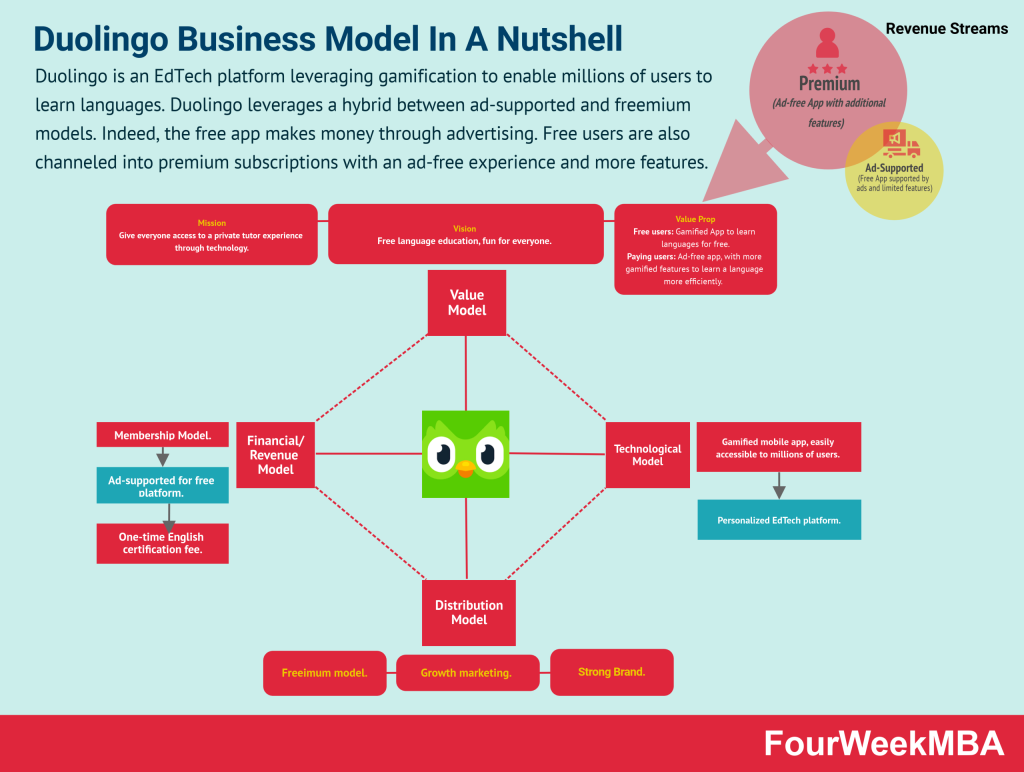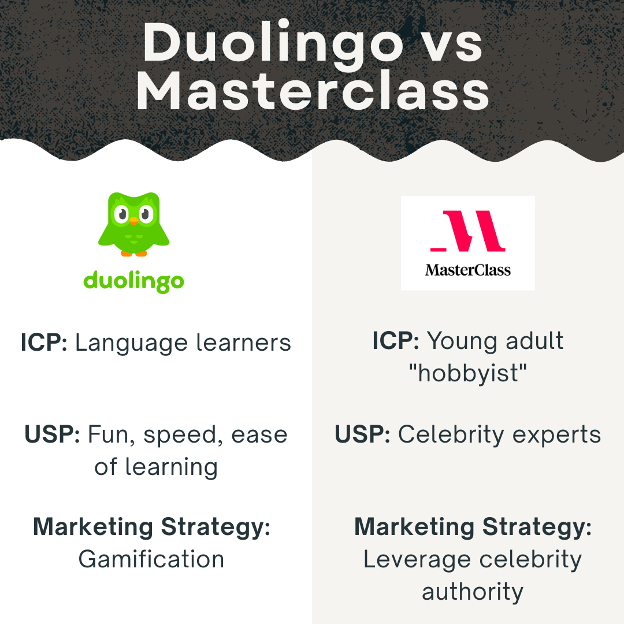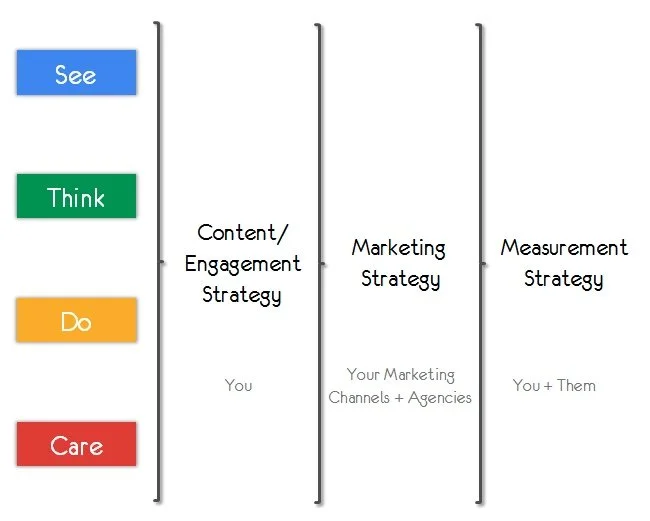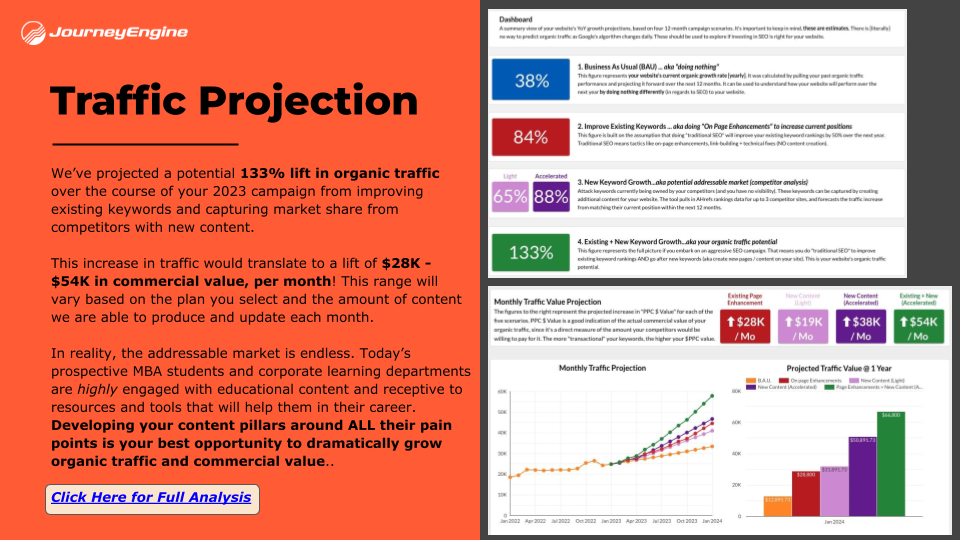THE 5 EdTech Marketing Strategies You Need for 2024
As the EdTech and online education industries continues to evolve, so must your EdTech Marketing Strategy.
Avoid wasting your budget chasing vanity metrics.
In this article, we show you how to create a strategy that generates sales, pipeline and revenue.
And the supporting tactics you need to explode growth.
It’s easy to get caught up in the excitement of various tactics and channels.
But before diving into the nitty-gritty of execution, it's essential to understand what a marketing strategy truly entails.
Table of Contents
What is an EdTech marketing strategy?
A marketing strategy goes beyond the specific actions and tactics employed to promote a product or service.
It encompasses the broader picture of a company's brand-level strategy and its differentiation from competitors.
How a business positions itself, and how that positioning is reflected in its overall messaging.
To illustrate the disparity between marketing strategy and tactics, let's consider a few examples.
Edtech marketing strategy examples
Duolingo
Duolingo is an EdTech company specializing in language learning software.
Their ideal customers are individuals who are eager to find the most effective way to learn and retain a new language.
Duolingo's marketing strategy revolves around showcasing the gamification features of their program.
By emphasizing the fun, speed, and ease of learning, they position themselves as the premier solution for language learning.
There’s a great article here on EdTech Business models from our friends at FourWeekMBA. Check it out to learn more about EdTech positioning and business models.
2. Masterclass
Masterclass is a platform that attracts users through the authority and celebrity status of its experts.
People are drawn to Masterclass because they want to learn from industry leaders they already trust and admire.
Consequently, Masterclass's marketing strategy is distinct, leveraging the expertise and reputation of its instructors to appeal to their target audience.
3. Quantic
Quantic caters to professionals looking to advance their careers, secure new roles, and increase their salaries.
While both Duolingo and Quantic are educational programs, their marketing strategies diverge due to different customer pain points.
Quantic's audience is less concerned with pedagogical features and more focused on achieving tangible business outcomes.
Their higher education content marketing strategy revolves around addressing these specific pain points.
We increased this EdTech product’s revenue by 20X — through organic traffic!
✅ Page 1 Ranking on Target Keywords for all Content Pillars.
📈 3X the Organic Site Traffic (Hockey-Stick Growth)
💲 PPC Value Upwards of $100K per Month (Ahrefs).
💰 20X Increase in Conversion Value (per Google Analytics).
🔄 29X ROI for JourneyEngine’s Content + SEO Service.
Want to see how we did it, step-by-step?
Two Common Mistakes in EdTech Marketing Strategy
Mistake #1: Reversing the order of marketing operations
Here is the simple formula for effective marketing campaigns:
Content + Promotion + Measurement
That’s it.
Great marketing campaign incorporate each of these.. IN THIS ORDER!
Avinash Kaushik wrote a classic post on this framework here.
One of the most common mistakes for early stage EdTech and eLearning companies is attempting to engage in social media marketing without a library of content that adds value and addresses your prospects actual pain points using product-led content.
Without a these resources to draw from, you’ll face challenges in creating meaningful and consistent social media campaigns.
To avoid this, you need to prioritize building a library of valuable content that addresses customer pain points.
First and foremost.
Some companies jump straight into promoting sales pages and conversion-focused messaging without first providing value through helpful content. That’s a mistake.
Resources that entertain, engage, and solve problems are the ONLY was to build trust and credibility with an unaware (cold) audience.
Once this foundation is established, you can gradually introduce sales messages and promote their content assets through various marketing channels.
Mistake #2: Selling the Shovel (Instead of the Hole)
Your prospects DON’T care about the inputs (features) of your product.
They could care less how long and hard your product team has spent developing (sorry).
They care about one thing: the output (benefits) to them.
Take, for example, Quantic from the example above. Their prospects aren’t overly interested in platform or the pedagogy.
So focusing only on the platform in marketing messaging would be a classic case of "selling the shovel".
Instead, their prospects pain points revolve around their difficulty advancing in their career, being promoted into executive positions.
And on the enterprise sales side; companies struggling to train their executives in leadership skills
So they focus on those pain points in their content.
They create resources and guides on how to solve these pain points. And then weave the product back into the content using student and enterprise case studies.
Differentiating Your EdTech Marketing Strategy
Step 1- Identify Pain Points 😣
Deeply understand your ideal customer profile and their pain points.
This knowledge can be acquired by engaging with internal team members who regularly interact with customers.
Sales teams
Support teams
Customer success teams
These can provide valuable insights into the challenges customers face.
By effectively communicating your solution and addressing their pain points, you can guide potential customers through your marketing funnel and convert them into loyal advocates.
Here are some strategies to help you identify and address common customer pain points:
Conduct surveys to gather feedback from customers
Monitor social media channels for comments and feedback
Provide excellent customer service and support
Regularly update your product or service offerings to meet changing needs
Offer training and resources to help customers get the most out of your product or service
Regularly revising and providing resources to help customers utilize your product.
Step 2 - Solidify Your UVP (Unique Value Proposition) 💎
Crafting a unique value proposition and developing targeted marketing messaging is the next step.
Clearly communicate how your product differentiates itself from competitors and addresses customer pain points more effectively.
The goal is to story-sell your product as the optimal solution to your customers needs.
Step 3 - Design Your “Value Ladder” 🪜
If you want to get the best possible ROI from your content then you need to strategically guide potential learners through a journey of increasing value — from free to premium.
Enter the "value ladder" — a marketing approach designed to take customers on a journey from low-priced entry-level content to a high-priced premium offer.
For example, let’s take edX.
They have a highly sophisticated, multi-tier value ladder starts with free courses and ends with masters programs valued in the tens of thousands..
It works by generating interest in free courses through Product-Led Content.
And then sequentially upselling free course students into higher tiers over their lifetime with the company, using marketing automation and other channels.
Check out my LinkedIn post for more detail:
Ok we’ve covered a lot in this article so far.
At this point you should know the difference between an overarching marketing strategy and individual tactics.
So, let’s examine the latter now…
EdTech Marketing Tactics
I. SEO For EdTech Companies
Understanding the Real Value of SEO
At the outset, it's essential to recognize that SEO has evolved beyond merely trying to rank for a single high-volume keyword.
While ranking for specific terms is valuable, it is often challenging to outrank established authority sites for competitive keywords.
Focusing on customer pain points is one of the few remaining “blue oceans”.
So, we’ve adopted a broader approach.
Effective SEO now means understanding the customer journey and identifying the pain points your products address.
Now, we conduct thorough keyword research and align content with customer needs.
That way?
Our clients attract organic traffic that is more likely to convert into leads and customers.
Here’s our new keyword research process…
1. Identify customer pain points by engaging stakeholders from sales, support, and customer success teams.
2. Create a list of topics that resonate with the clients target audience.
3. Validate these topics using keyword research tools to identify primary and secondary keywords relevant to their content.
Hire us for your next campaign here
Optimizing Website Structure and Architecture
EdTech companies should focus on two categories of pages on their websites: content pages and sales pages.
Content pages serve as a library of topics that provide value to their target audience and introduce them to the brand.
Sales pages, on the other hand, showcase the edtech product or service and aim to convert visitors into customers.
The key is to tie these pages together gracefully by transitioning from value-driven content to product and service offerings.
A seamless flow from informative content to sales pages improves user experience and increases the likelihood of conversion.
[Screenshot]
The Importance of EdTech Backlinks
Backlinks remain a critical factor in SEO rankings after optimizing on-page elements.
However, building high-quality backlinks requires having a critical mass of valuable content on your website.
Reaching out to relevant publishers and promoting content that offers free value to audiences can lead to more effective link-building efforts.
Technical SEO Issues
Technical SEO is still essential for ensuring that websites are search engine-friendly and that there are no red flags impacting search visibility.
However, the emphasis on technical audits has decreased.
You should focus more on creating high-quality content and less on frequent technical audits.
Resolving any technical issues that arise promptly is crucial to maintain search traffic and leads.
2. Email Marketing For EdTech
Email campaigns play a crucial role, particularly in the early stages of the buyer journey.
The primary objective is to generate interest, engage the audience, and build a subscriber base through valuable content.
Eventually, email can become an essential tool for lead generation and nurturing.
Email campaigns serve various purposes in EdTech marketing. And there are multiple series’ you can employ…
A trial-to-paid sequence to convert trial users into paying subscribers.
Relationship-building sequences help convert marketing qualified leads into trial users.
Topical newsletters maintain interest and provide ongoing value to customers, educating them on how to address their pain points effectively.
Despite email sometimes being overlooked in favor of other marketing efforts, it is a crucial component.
The majority of website visitors are not immediately ready to take desired actions, such as signing up for a free trial or making a purchase.
Therefore, implementing email capture mechanisms, such as content upgrades or opt-in forms, is essential to capture interest and initiate ongoing correspondence.
Building relationships
The relationship-building aspect of email marketing is also significant.
By leveraging a series of emails, businesses can guide prospects through a journey of understanding why and how their product solves their problem.
This gradual process helps build belief and trust, leading to more engaged and committed users.
Additionally, in the case of demo calls, a pre-sold prospect resulting from email correspondence is more likely to convert compared to a cold lead.
[Insert belief map]
Gated Content [Content Upgrades]
Gating mediocre content like a precious diamond that needs to be protected is silly.
No one wants it anyway 🙅🏾♂️
You’ll receive no downloads or leads.
Then rattle off blanket statements like “gated content doesn’t work”.
Of course it doesn’t if you can find what you're gating elsewhere... with generative AI or a simple Google search.
People are going to bounce and do just that!
Here’s a few scenarios where gating content makes perfect sense…
↳ You’ve got a unique template that helps users reach their desired outcome faster
↳ You custom built a tool that cuts users time to result in half
↳ You’ve executed independent research that you can’t find elsewhere
3. Leverage Data
EdTech companies can leverage data and analytics to improve their marketing strategies in several ways:
Cut Down Your KPI Metrics
Choose a few key metrics that are relevant to your role and can be realistically tracked and measured over time.
This could include leads, revenue, click-through rates, conversion rates, or other relevant performance indicators.
Set Targets and Segment by Content and Channels
Define specific goals for each content piece and marketing channel in advance, and evaluate performance against these targets regularly to determine which pieces of content and channels are effective and should be prioritized.
Notice how in the below content calendar we’ve set a target for leads and organic traffic for EACH AND EVERY content piece.
And then check out how we’re segmenting our analysis by content type here in this dashboard.. WOAH our blog content is pulling in an 11X lift in SQL’s!
That’s targeting and segmentation in action, baby!
Make Sexy Dashboards! (Seriously though).
If you give your marketing team an unsightly “data puke” with 50 metrics on it.. that’s the response you should expect. 🤮
So give your team a pretty marketing dashboard that they actually comprehend. One they’ll even find “fun” to use!
Focus on presenting the most important information in a clean and simple format.
Or just steal ours! 😉
Want your own Product-Led ROI Forecast?
Learn what Product-Led content can do for your business
Discover the Biggest Opportunities for Your Website
Forecast Traffic and ROI from your Campaign
Sell-through Product-Led Content to your Team
Automate the Flow of Data
Utilize ETL (Extract, Transform, Load) tools such as Supermetrics or Stitch to automate data collection and reporting processes.
This helps save time and allows teams to focus on analyzing data and deriving insights rather than manual data management tasks.
By leveraging data and analytics in these ways, EdTech companies can gain a deeper understanding of their marketing performance, identify areas for improvement, and make data-driven decisions to optimize their strategies.
4. Social Media Marketing For EdTech Companies
When it comes to distribution, social media platforms play a vital role in amplifying your content and engaging with your target audience.
Treat your website as a library of resources that cater to customer needs.
Social media then becomes a platform to repurpose and distribute these resources effectively.
Organic social media engagement is about igniting conversations with intriguing content snippets that spark interest and generate attention.
It's an opportunity to build trust and authority by offering unique perspectives as a human and as a business.
On the other hand, paid social media strategies can be used to move potential customers further down the marketing funnel, leveraging retargeting and tailored content to specific audience segments.
5. Prioritize User Experience (UX)
As an EdTech marketer, you may have come across the term 'user experience' or UX being used often.
But what does it really mean?
And why is it so important in your marketing strategy?
In simple terms, user experience refers to how easy and enjoyable your website or app is to use.
Creating a pleasant connection between the user and your product is essential to ensuring that they return.
Google has made it clear that they prioritize websites offering superior user experience. This means that if you want to rank higher on search engine results pages (SERPs), focusing on UX should be at the forefront of your site's design layout or when creating new features.
Role of Google Ranking Factors in Prioritizing User Experience
Google emphasizes UX in order to ensure users have the most enjoyable online experience possible.
They achieve this by using certain ranking factors related to UX, like mobile-friendliness, safe browsing and HTTPS-security.
To put it simply: If Google sees that people enjoy using your site - meaning they stay longer and interact with more content - then its algorithms will likely boost its visibility in SERPs over time.
Ways To Improve Site Usability And Overall User Satisfaction
Simplicity: Keep it simple, stupid. Make sure everything from navigation menus to contact forms are straightforward and easy-to-use. Don't overwhelm visitors with too much information all at once; instead break things down into manageable chunks.
Faster Load Times: Ain't nobody got time for slow-loading sites. Use tools like Google PageSpeed Insights to check your page speed and optimize it for faster load times.
User-Friendly Design: A clean design not only looks professional but also helps users find what they're looking for quickly without any confusion. Make sure your design is consistent across all pages and devices.
A positive user experience often translates into higher visitor retention rates as well as improved search engine rankings over time.
So whether you're just starting out with SEO or are already an expert, remember: don't neglect UX.
This doesn't mean making drastic changes overnight - rather continuous small improvements based on feedback from real users will lead towards better usability and satisfaction overall - ultimately boosting both customer loyalty and organic traffic growth alike.
The Future Of EdTech Marketing Strategies
The EdTech industry is evolving in terms of marketing strategies, and several trends are expected to be important in the coming years…
Automation and AI
The advancements in data automation and AI are transforming various aspects of marketing.
By automating repetitive tasks and leveraging AI capabilities, marketers can focus more on creating original perspectives and providing unique value.
Originality and Expertise
Regurgitating information from other sources is becoming less valuable, and search engines like Google prioritize content that demonstrates expertise, experience, authoritativeness, and trust.
Integration of Marketing Channels
The silos between different marketing channels are expected to diminish and dissapear.
Strategies implemented on social media will have more impact on website content, and advancements in technology will facilitate better integration and coherence across channels.
Human Value and Creativity
As automation takes over mundane tasks, marketers can invest more time in activities that require human creativity and provide distinct value.
Coming up with original perspectives, developing opinions, and infusing content with personality and expertise become essential.
Overall, the EdTech industry is moving towards more strategic and impactful marketing approaches that leverage automation, AI, originality, and expertise to deliver value to learners and customers.
At Journey Engine we stay on the cutting edge.
In fact, we never start a campaign before doing a full traffic projection.
We’ll project the amount of traffic and leads you can expect from an organic campaign.
We’re currently offering these projections for free, you can take advantage of this offer here.
Want Your Own Product-Led Content Strategy and ROI Forecast?
Learn what Product-Led content can do for your business
Discover the Biggest Opportunities for Your Website
Forecast Traffic and ROI from your Campaign
Sell-through Product-Led Content to your Team








